Tropical Tree: Citrus Tree root growth and branch pruning [Bonsai]
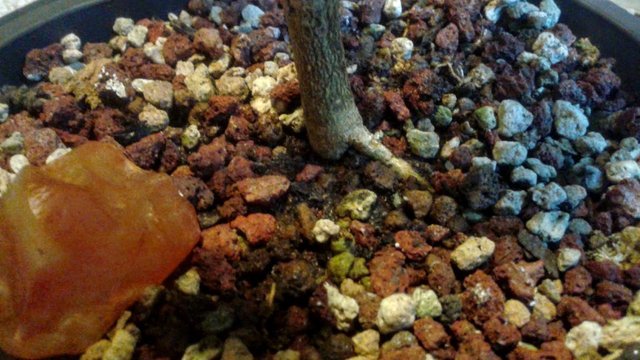
The large surface roots, known in bonsai as the nebari, on my lemon tree are beginning to thicken up. Having many small roots, a porous soil with access to lots of fresh oxygen and clean water, and small container size all contribute to development of thicker surface roots that give the tree the visible appearance of age, strength, and stability.
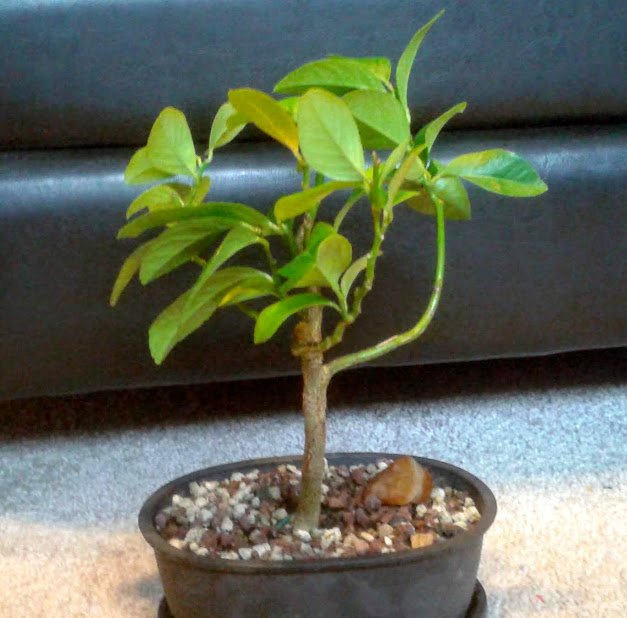
In the winter months, I bring my citrus trees indoors. Tropical trees cannot tolerate the cold temperatures where I live, but that does not mean that I cannot successfully grow these wonderful plant species I always dreamed of growing. I don't have to live in the tropics to enjoy the many exotic varieties of fruiting trees that exist in the world. They do quite well living indoors during the winter months, so long as I have enough space, and I am able to give them a bit of extra tender loving care. Keeping them small allows me to take care of more tropical trees every year.
If I can do it, you can do it!
In this post, I will be pruning the tree to help it maintain its small size. Pruning a bonsai tree also helps it to develop new buds, leaves, and shoots, and it also promotes smaller leaves to form, so the larger ones can be removed. Having many small branches is ideal in bonsai, and it gives the tree better proportion to the size of the pot. The roots are also pruned in the same way. However, during this time of the year the tree has become dormant, and I will only be focusing on branch pruning.
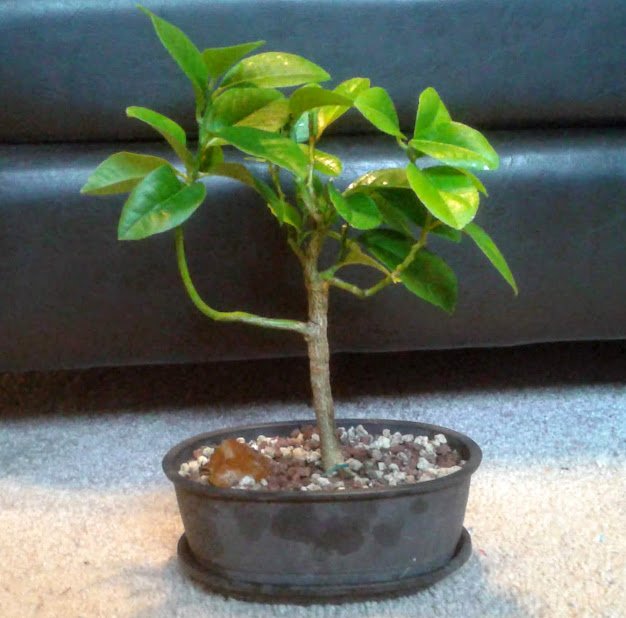
Historical Information:
ID: 0002
Nickname: Lita
Type: Citron limon
Age: 4 years
Grown: from seed (common supermarket variety produce)
Last repotting: early summer 2017
Wired: early summer 2017
Last time I shared this tree was a year ago.
Check out my earliest post on this tree to see its changes is growth.
Strategy
This tree is still very young, and so it has a tendency to push all growth into continuing the length of the branches upwards. In nature, a tree like this will eventually develop a dominant branch which becomes the central leader, and eventually continues the trunk upward as it reaches closer to the sun to compete with other trees.
To combat the tree's tendency to waste its early years only developing a few long dominant branches, I will use directional pruning, to stimulate growth of new stems and leaves along the current branches. By reducing the length of branches down to the lowest one or two leaves, the branches can be reduced in length, and keep the trees small enough to live in a bonsai pot.
Also this tree has a strong, straight, and thick trunk that is forming without much taper or curve. I will be pruning the current central leader of the tree, to establish a new apex. This will force the trunk into a curved taper, by using an alternate top branch which has better shape, more options for new branches to stem forth from, and it will have a slimmer appearance at the top of the tree. Overall I think this will make the tree seem more natural in appearance to have a thinner top with small leaves and branches, than a thick top with the largest leaves and branches.
Refer to my drawing below for an overview of how I plan to prune the tree to take on a new shape.
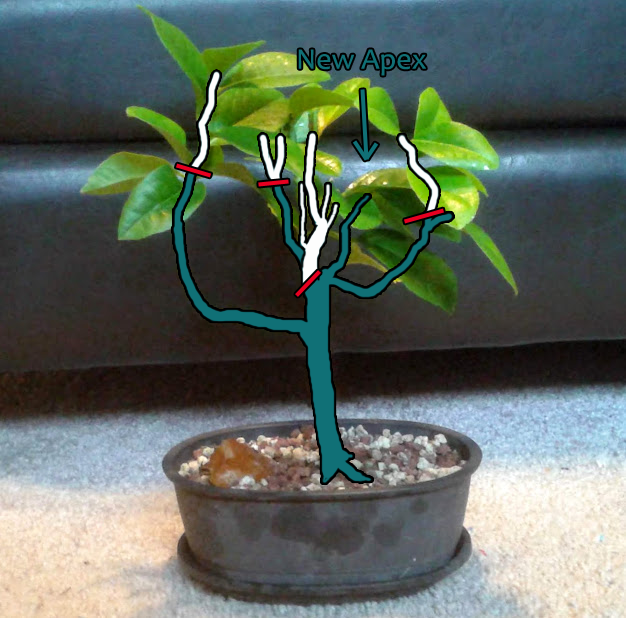
First I prune the left branch. It has to be pruned further away from the trunk than I prefer, but I want to maintain at least one healthy leaf node on it. If it develops leaves an branches closer to the trunk in the future, then I can prune this branch much shorter. It has a strange shape right now that i do not think looks very natural. It reminds me of a playground branch that might hold a playground swing.
Hmm, that might be a funny little accessory to add in the future. Not very classic in bonsai to add ornaments to decorate, but very much like me to be nonconformist and break away from traditional art rules.
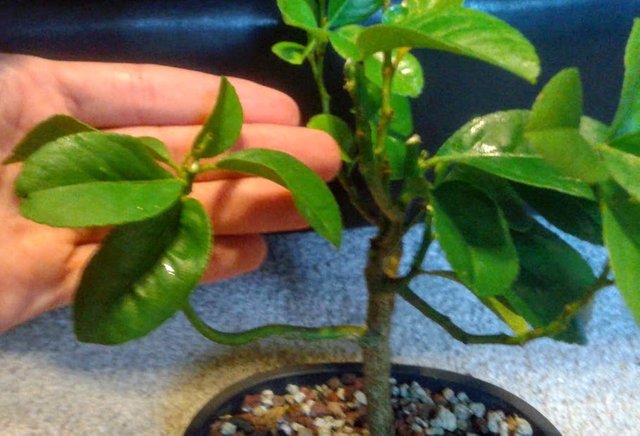
Plenty of healthy leaves remaining around the new cut mark. The surrounding green growth will also help the cut end to heal over.
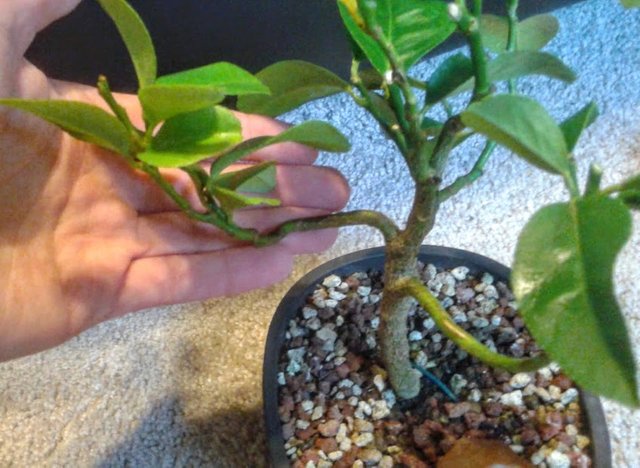
Next, I examine the back branch, which connects quite a bit lower than is evident from the front view.
It separates into a small leafing branch, and splits into a longer thicker branch that extends the branch length up and out. The choice is clear. Trim to the smaller branch.
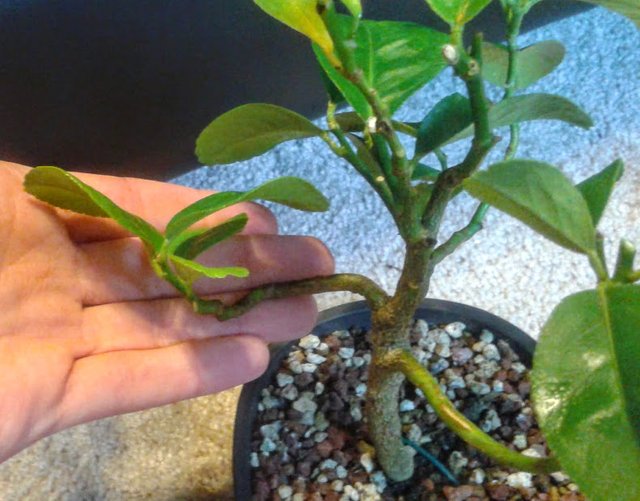
The curve of the branch is much more evident than it was before.
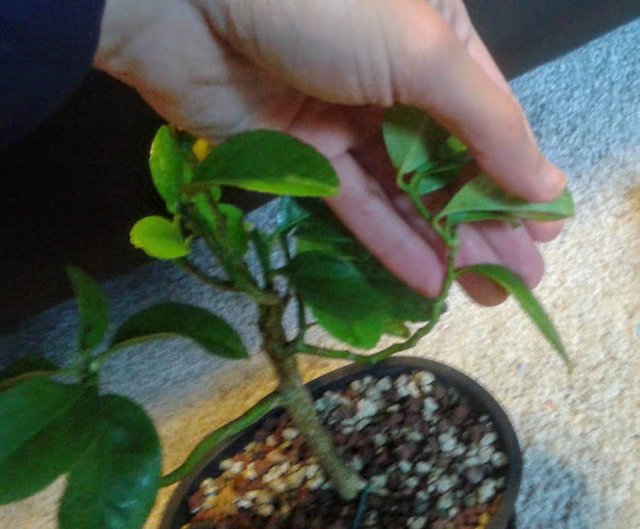
The right branch has many old leaf nodes along its length. Since the leaves formed in an alternating shape along the branch, it caused the branch to have a slight zig-zag shape to it.
Once I prune this branch to the length of the first cluster of leaves, we will have to wait an see what happens.
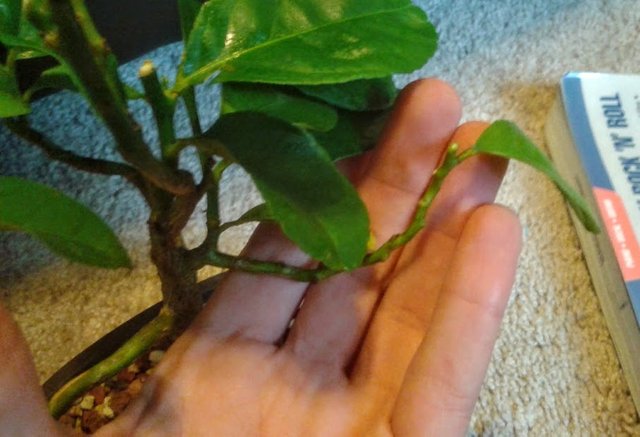
In time, perhaps new shoots will appear along the old leaf nodes.
Or maybe a new shoot will appear at the end, attempting to extend the length of the current branch.
Maybe the branch will not receive any new growth, as the other branches will also be requiring energy to form new growth. In some cases the tree will allow one of its less effective branches to die.
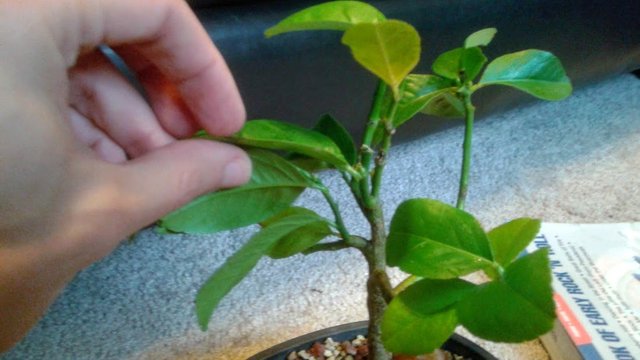
With the lower branches now reduced in length, it becomes easier to examine how much of the top of the tree should be pruned. When pruning the apex of the tree, it has a very direct affect on how the tree will grow in the upcoming season, because this is the area of the tree that tends to receive the most direct growth energy, being closest to the sun.
There are many competing leaves, branches, and stems currently on the top of this tree. I am concerned that this tree is forming so many thick branches at the top, and they are all vertically parallel. It could mean that will develop into triple or quadrupedal trunk heads, which will eventually squeeze and compact against each other. This is bad, as it promotes lack of light exposure, lack of airflow, excessive humidity, and promotes mold, insect nests, other diseases.
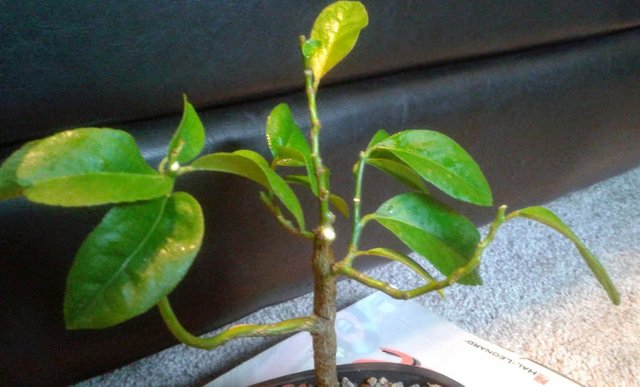
I decided to eliminate the entire trunk just below the problem area, and instead develop the small secondary branch coming off the branch underneath to become the new apex.
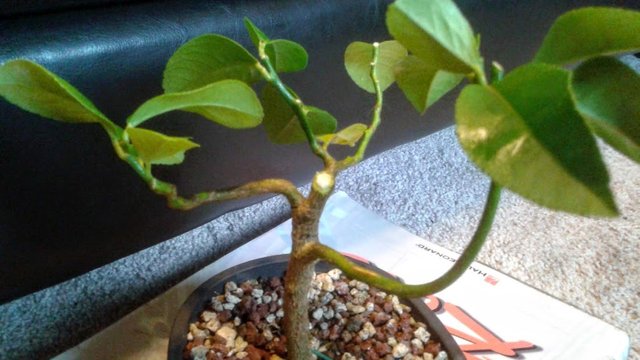
With a clean cut, all the way up against lower branch, it causes a nice curve. It is okay to carve around the cut end to round off the corners of the cut.
To prevent decay that will harm the adjacent branch, many people use a cut paste. Such treatments will kill off bacteria and infections, and seal off the living inner plant flesh (the wet cambium layer under the bark) from the drying effects of the air.
This time I chose to use honey as a natural substance, because it is similar to sap, has natural sugars that the tree can absorb, and it should create a sticky layer that air cannot penetrate through. I also used Vasaline (petroleum jelly) to coat the branches with an added layer of moisture that protects the bark from the drying affects of the air.
Even after a day, the heat inside our house and the needs of the tree causes both of these substances to dry on the wood. I believe the pores inside the wood have probably been able to form a protective wound to prevent air from continuing to rot the wood, because the branches are still looking healthy weeks later.
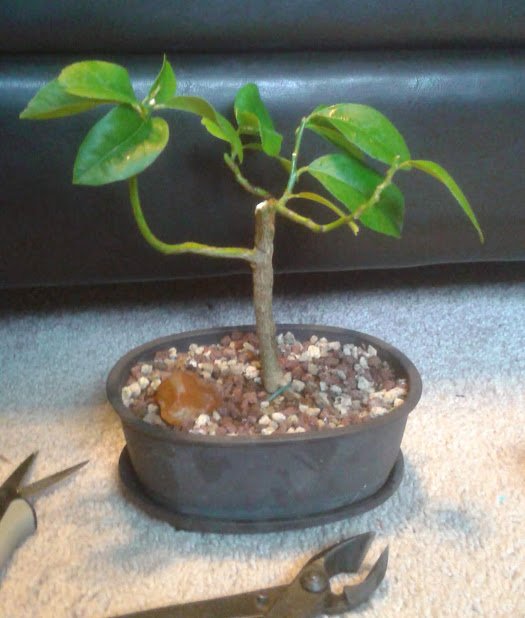
Above we see the finished tree.
Even though this tree is in a dormant state, I am still giving it fresh water every three days or so to prevent the wood from drying out. Especially with the recent cuts, it has more pores exposed for the tree to vent out moisture. The tree has fewer branches and leaves to support, so hopefully the roots will have an abundance water to properly hydrate the tree.
It is a myth that trees store their energy in the roots which its gets from food in the soil. The entire vascular system of the tree holds the energy (carbohydrates) it feeds on, and these sugars are made largely through photosynthesis with the sun through the leaves. After a pruning, a tree will have less energy than it had before, so it is important to be attentive to the basic needs of a tree after it has been pruned.

One of the last steps I chose to make was to release the anchor wire binding this tree down into the pot. The wire was cutting down over the top of this beautiful nebari that has been developing, and I think this tree is telling me to let that root have some more space. The nebari should have plenty of strength to hold the tree down firmly into the pot without need of supportive wires underneath. In the Spring, I may need to reconsider wiring the tree back down to prevent animals from pulling the tree out of the pot, but for indoors, I do not need to worry.
Photos in this post are all #originalworks by @creativetruth, unless stated otherwise.
Find me on discord and chat with other tree growers, bonsai enthusiasts, and gardeners. We have quite a few accredited experts filling out our ranks, and a helpful Spanish-speaking community.
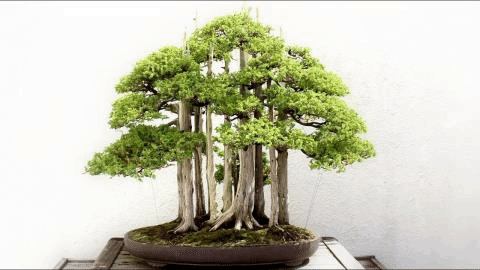

Hi creativetruth,
Visit curiesteem.com or join the Curie Discord community to learn more.
Thank you for the extremely generous upvotes. It really makes me feel happy that others feel this content is so valuable. Every bit goes to powering up, so I can curate deserving posts manually. Next goal is 2000 SP.
This lemon tree is looking very good! I have a lemon tree in the back yard. It wastes its growth each season long new branches shooting straight up. We cut back to the main branches. Interesting to use honey on pruning wounds. Makes perfect sense.
Yes, using honey is much cheaper that bottled glue. Glue tends to dry and clog the nozzle (lots of wasted glue), and some stain the wood. Honey is non-toxic, so easy to use with fingers.
Keep your tree small, and the fruit will be easier to reach. Reduce the amount of fruit growing on each branch, and the tree will grow healthier with better tasting fruit.
I never thought of bonsaing a lemon
Posted using Partiko Android
Quite an art. You've just given me an idea for some plants I have.
Of course, I'll have to learn a lot about this art.
I tend to throw seeds of tangerine, sapodilla (níspero), soursop (guanabana) and other fruits in a small 1x2 piece of dirt I have where I live, but after some months I have to give those plants away or take them to an open space where they can develop.
It's frustrating when we have plants that will grow big but we do not have room to plant them. On the other hand, I wonder if those plants can be made into bonsais.
Interesting thoughts there.
Some fruit trees only have a short lifespan, so you have to make a judgement call as to how long you want to train it before you are ready to use it for harvesting fruits.
Generally bonsai is not recommended by fruit growers. To get maximum yield, fruit trees are usually grafted onto a better rootstock, to provide maximum health to the tree for the region and location it will be grown in. Usually they want the tree developing as much quality fruit as possible during its lifespan.
For home growers, I think bonsai (or trees pruned to dwarf size) can be a good way for growers to work within a smaller space. Many people only want to grow a fruit tree for the novelty to be enjoyed by one or two people enjoying limited amounts of fruit. Trees can be trained to survive in large containers, and have their roots and branches pruned to the shape of a smaller healthy tree. Having fruit that is easy to reach without ladders, I think is a great benefit for kids, handicapped, the elderly, or folks who are accident prone or scared of heights.
That's a great idea to plant trees in a small part of the garden, and then dig them up later on once they have become stronger. I bet they grow quickly in good soil.
Thanks. Very generous of you to share all this bonsai wisdom :)
They do grow fast and healthy once they are transplanted. I've checked some of the mango, soursop and nispero trees i've given away in the last few years and they are ready to give fruits.